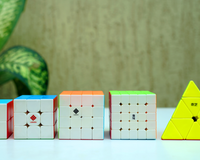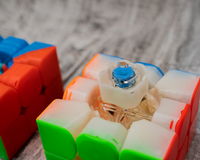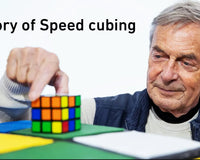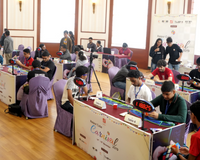How do you scramble a Rubik’s Cube?
The best way is to use scramble algorithms generated by timer apps like upCube or csTimer, which give you a fair, random sequence of about 20–25 moves. For casual practice, you can also do 20–30 random moves by hand, but algorithms ensure unbiased scrambles just like in competitions.
Why Scrambling is Important?
Before diving into the how-to, let's first understand why scrambling a Rubik's Cube correctly is important. A properly scrambled cube:
- Ensures Fairness: Whether you're competing in a speedcubing competition or simply timing yourself, a well-scrambled cube guarantees that each solve is unique and fair.
- Improves Skills: Different scramble patterns challenge you in various ways, helping to enhance your problem-solving skills, pattern recognition, and speed.
- Prepares You for Competitions: In official competitions, cubes are scrambled according to specific algorithms. Practicing with properly scrambled cubes prepares you for the real deal.

The Basic Method: Random Scrambling
The simplest way to scramble a Rubik's Cube is to perform a series of random twists. While this method is easy, it's not the most effective, especially if you're looking for a true scramble that presents a different situation every time. However, for casual practice or beginners, random scrambling can be a good starting point. For a basic scramble, 20 to 30 moves are usually sufficient.
The Recommended Method: Using Scramble Algorithms
For a more precise and challenging scramble, especially if you're preparing for a competition or serious practice, using scramble algorithms is recommended. These algorithms are sequences of moves specifically designed to ensure a truly random and unbiased scramble each time.
Understanding Scramble Notation:

Before using scramble algorithms, it's essential to understand the standard Rubik's Cube notation:
- U (Up): Rotate the top face clockwise.
- U' (Up Prime): Rotate the top face counterclockwise.
- D (Down): Rotate the bottom face clockwise.
- D' (Down Prime): Rotate the bottom face counterclockwise.
- L (Left): Rotate the left face clockwise.
- L' (Left Prime): Rotate the left face counterclockwise.
- R (Right): Rotate the right face clockwise.
- R' (Right Prime): Rotate the right face counterclockwise.
- F (Front): Rotate the front face clockwise.
- F' (Front Prime): Rotate the front face counterclockwise.
- B (Back): Rotate the back face clockwise.
- B' (Back Prime): Rotate the back face counterclockwise.
Applying the Scramble Algorithm:
- Find a Scramble Algorithm: You can find official scramble algorithms online, generated by software or provided in speedcubing resources.
-
Follow the Sequence: Starting with the cube in the official orientation as used in WCA competitions, for example; 3x3 Rubik’s Cubes are scrambled with white on top and green in front(as shown in the image). Perform the moves in the algorithm one by one. Be precise in your turns, ensuring that each move is executed correctly.

-
Double-Check Your Work: After completing the sequence, review the cube to ensure that you've scrambled it correctly. A spread out image of the cube is usually given along with the scramble to match it with your cube and make sure you’ve done it right.
Random Moves vs Algorithm Scrambles
Method Moves Needed Best For Pros Cons Random Moves 20-30 Casual Practice Quick, easy, no tools required Not fully random, may repeat Algorithms 20-25 Competitions / serious practice Fair, unbiased, official WCA style Requires learning notation
"Sample Scramble Algorithms"

FAQ
Q1: How many moves should I use to scramble a Rubik’s Cube?
20–30 random moves are enough casually. Official WCA scrambles use ~20–25 moves for fairness. Algorithms are more accurate.
Q2: Where can I find scramble algorithms?
WCA TNoodle software (official competition scrambles).
Timer apps like upCube.io, csTimer, or other cubing timers.
Q3: Does it matter which color is on top when scrambling?
In competitions, yes — white on top, green in front. At home, orientation doesn’t affect randomness, but it’s good to build the habit.
Q4: Do bigger cubes (4x4, 5x5, 6x6, 7x7) need scramble algorithms too?
Yes. While bigger cubes naturally become more mixed with random turns, competitions still use algorithms for fairness. Timer apps can generate scrambles for all cube sizes.
Final Thoughts
By understanding the importance of a good scramble and learning how to execute it correctly, you set yourself up for a fair and challenging solve every time. So next time you pick up your cube, take a moment to scramble it well, it will help you become a better solver in the long run. Happy cubing!
































